Ever wondered how to start your puppy on the right path? Effective puppy training is key to their happiness. When you bring a puppy home, you become their teacher, guide, and mentor. Teaching them good habits from the start is crucial.
Learning the basics of puppy training is essential. It helps create a happy, well-adjusted pet. Let’s explore how to begin this journey together.
Understanding your puppy’s mind and setting up a good environment are important. We’ll cover the basics of positive reinforcement, crate training, and handling common behaviors. With patience, consistency, and our tips, you’ll build a strong bond with your puppy.
Understanding Puppy Psychology
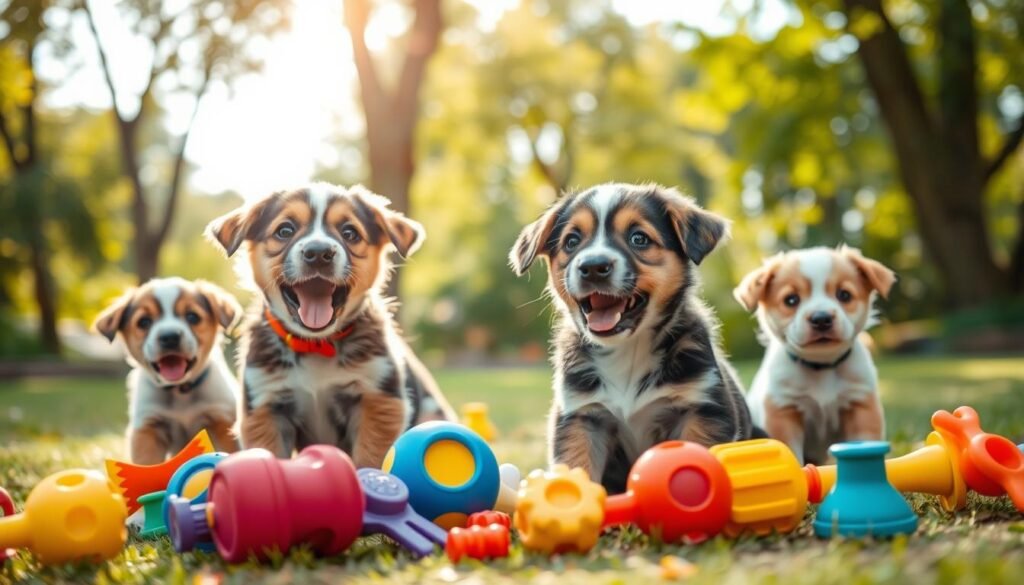
Quick Recommendation. Our blog is filled with tips and tricks for training your puppy or dog. If you’re seeking a comprehensive online training program, we recommend K9 Training Institute.
To really get good at training your puppy, you need to understand their behavior and how they see the world. Puppies learn by exploring with their senses and experiences. This shapes their young minds.
Young puppies soak up new things quickly. Early social experiences are key. Positive rewards like treats and praise help them learn good habits. Knowing what not to do is also important for their growth.
Learning patterns in puppies are very important. From the start, they learn from everything around them. This learning affects their obedience and social skills. By using this natural ability, you can guide their education well.
Also, puppies are naturally curious and need to connect with others. This includes humans and other animals. Knowing this helps you build a strong bond with your puppy. It’s not just about training; it’s about understanding and connecting with your pet.
Getting into puppy psychology is more than just teaching them to obey. It’s about building a deep connection with your pet. With patience and understanding, you and your puppy can grow and learn together.
Setting Up for Success: Preparing Your Home
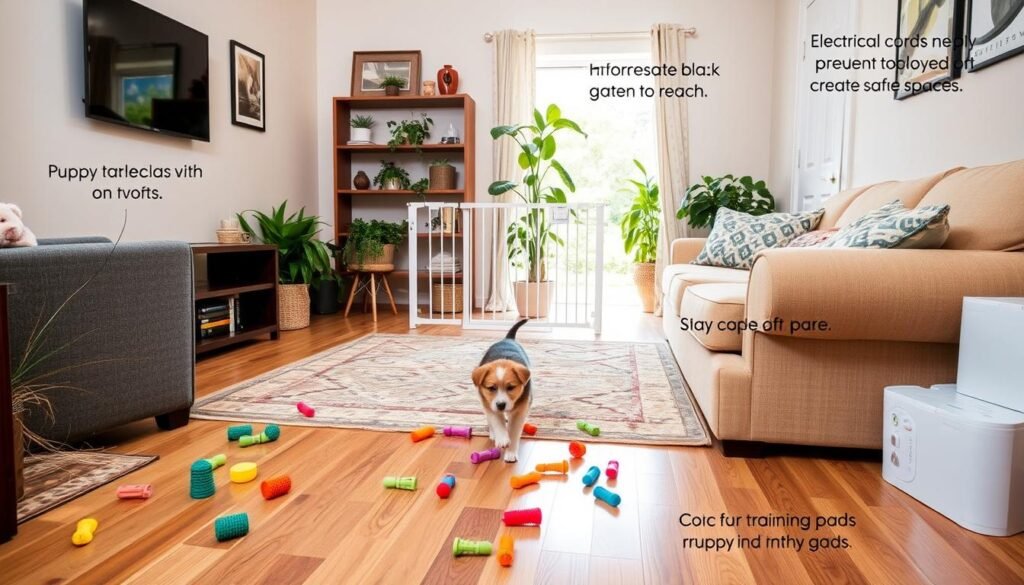
Before your new puppy arrives, it’s key to puppy-proof your home for their safety. By creating a puppy-friendly environment, you make your home safe and welcoming. Let’s look at ways to get your home ready, ensuring a smooth start for your new family member.
Start by securing items that could harm your puppy. Keep electrical cords out of reach and remove small objects that can be swallowed. In the kitchen, use childproof locks on cabinets to block access to harmful chemicals.
Make a special area for your puppy with a comfy bed, fresh water, and lots of toys. This spot will be their safe place. Also, set up areas for eating and playing. This helps with training and keeps your puppy’s behavior in check.
Puppy-proofing your home means setting clear boundaries for your puppy. Use baby gates or closed doors to keep them safe. This helps them learn their new space and supports their growth into a well-behaved dog.
Preparing your home well sets the stage for a happy relationship with your puppy. The effort you put in now will lead to a happier, healthier pet. Welcome home, puppy!
Essential Commands Every Puppy Should Know
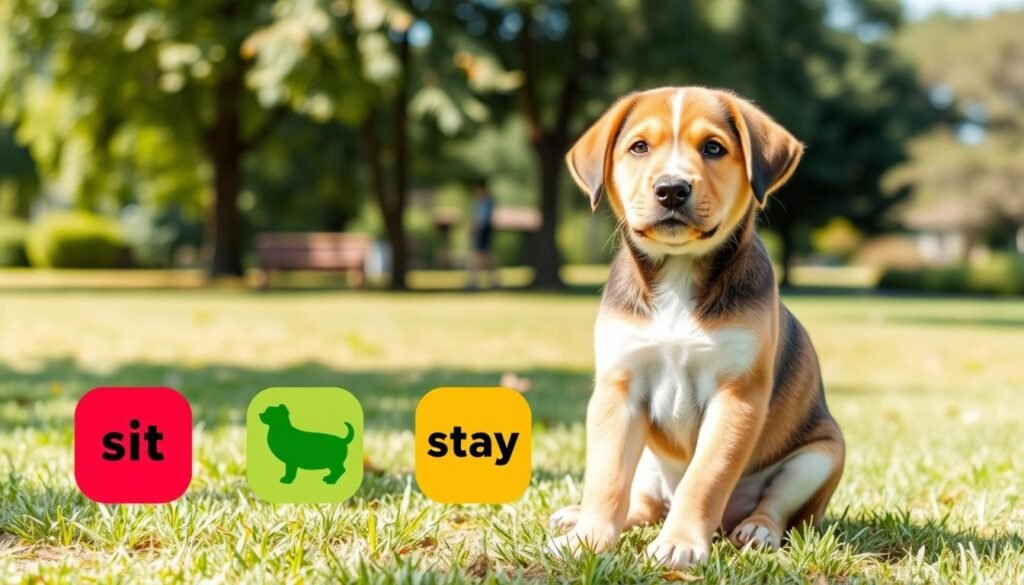
Learning basic puppy commands is key for obedience training for puppies. Puppies soak up new info quickly, making early learning ideal. Teach them “Sit,” “Stay,” “Come,” and “Leave it.” These commands lay the groundwork for more advanced skills.
“Sit” is a simple command to start with. Hold a treat near your puppy’s nose and move your hand up. They’ll likely sit to see the treat. Say “Sit” when their bottom touches the ground, then give them the treat and praise.
After mastering “Sit,” teach “Stay.” Have your puppy sit, then hold out your hand and say “Stay.” Take a few steps back. If they stay, reward them with a treat. Increase the distance and time as they get better.
“Come” is vital for safety and handling your puppy off-leash. Practice in a quiet area without distractions. Say “Come” while squatting and opening your arms wide. Reward them with treats and praise when they come to you.
“Leave it” helps with self-control. Place a treat on the floor and cover it with your hand. Say “Leave it” as your puppy sniffs. Reward them with a different treat when they ignore the first one. This command is useful and teaches good manners.
Good puppy training techniques need patience, repetition, and rewards. Short daily training sessions can make a big difference. Every puppy learns at their own pace, so adjust your methods to fit their learning style.
House Training Your Puppy: A Step-by-Step Guide
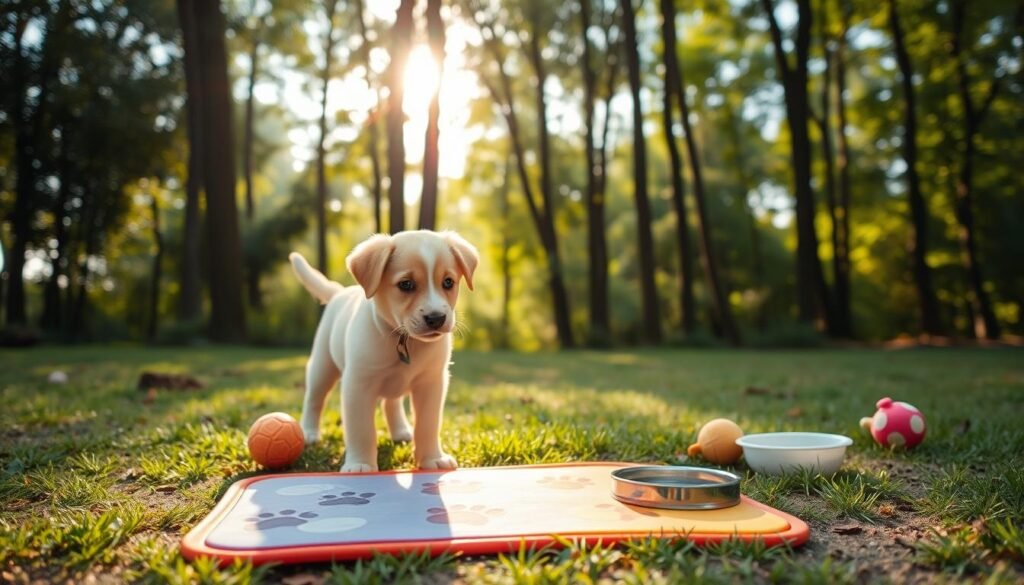
Quick Recommendation. Our blog is filled with tips and tricks for training your puppy or dog. If you’re seeking a comprehensive online training program, we recommend K9 Training Institute.
Starting to housebreak your puppy can feel overwhelming. But, with the right potty training tips and understanding of young dog toilet training, you’re on the right path. The secret to successful house training is a routine that works for both you and your puppy.
First, pick a specific spot outside for your puppy to go to the bathroom. Take them there after meals, naps, or playtime. Use a consistent command like “go potty” to link the spot with the action. It’s important to notice when your puppy needs to go, like when they sniff or circle.
Positive reinforcement is key to house training success. Praise and treat your puppy every time they go outside. This encourages good behavior and strengthens your bond. If there’s an accident inside, clean it up calmly and take them outside more often to avoid future accidents.
Consistency is crucial. Stick to a schedule for feeding and potty breaks to help your puppy’s digestion and elimination needs. It takes effort and patience, but the reward is a well-trained, confident dog.
Positive Reinforcement Techniques
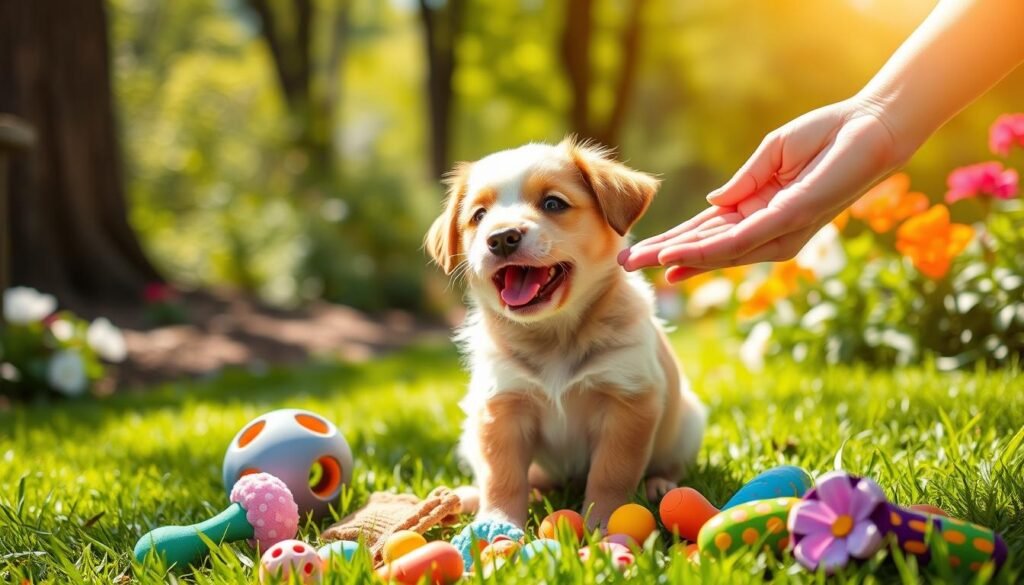
Positive training methods are great for teaching puppies good behavior. They also help build a strong bond between you and your pet. It’s important to understand how rewards-based training works.
This method rewards your puppy for good behavior, not punishing bad ones. It’s all about positive reinforcement.
Using positive reinforcement tells your puppy that good actions have nice rewards. You might give treats, praise, or playtime for good behavior. This shows them that what they did is great and they should do it again.
For example, teaching your puppy to sit involves saying the command and gently pushing their hindquarters. When they sit, give them a treat and lots of praise. This teaches them that sitting is a good thing.
The timing of rewards is crucial in rewards-based training. The reward should come right after the puppy does what you want. This way, they learn to connect their actions with the reward. With patience and persistence, training will be both successful and fun.
Crate Training Basics
Introducing your puppy to a crate is a key step in raising a well-behaved pet. Crate training offers many benefits, like helping with house-breaking and providing a safe space. A crate acts as a personal area for puppies, offering safety and peace, similar to their own room.
When you introduce your puppy to a crate, make sure it’s a positive experience. Choose a crate that’s the right size for your puppy. It should be big enough for them to stand, turn around, and lie down comfortably. Add a cozy blanket and some favorite toys to make it inviting and comforting.
Creating a crate training schedule is important. Start with short periods when you’re home, then increase the time as your puppy gets used to it. This routine helps your puppy feel secure and builds a sense of belonging. It prepares them for times when you need to leave them in the crate.
The crate should always be a positive place for your puppy. Feed them near or inside the crate and reward them with treats when they go in voluntarily. With consistency and patience, your puppy will see their crate as a safe, comfortable, and secure place.
Dealing with Common Puppy Behavior Challenges
If you’re frustrated with your puppy’s behaviors, you’re not alone. Many owners face similar issues. But, with the right strategies, you can tackle these problems. Let’s look at some effective ways to help your puppy develop better habits.
Puppy biting is a common challenge. Puppies bite to explore or get attention. To stop this, replace your hand or furniture with a chew toy. Be consistent and patient.
When your puppy bites, say ‘no’ firmly but calmly. Then, give them the chew toy. Praise them when they choose the toy, which reinforces good behavior.
Managing jumping up is another issue. Puppies jump for affection or excitement. But, it can be a problem as they grow. To manage this, ignore your puppy when they jump. Turn your back and wait until they have all four paws on the ground.
Once they behave correctly, reward them with attention and treats. This teaches them that keeping all paws on the floor is the best way to get your love.
Understanding why your puppy behaves a certain way is crucial. Many problems come from a lack of exercise or mental stimulation. Make sure your puppy gets enough physical and mental activity every day.
Training sessions, interactive play, and walks help reduce unwanted behaviors. Remember, consistency is key in teaching your puppy. Stay calm and assertive to reinforce good behaviors.
Be patient and persistent. Soon, you’ll see your efforts improve your puppy’s behavior.
Socialization Strategies for Puppies
Understanding the importance of puppy socialization is key for new pet owners. Socializing your puppy helps prevent future issues like fear and aggression. It also helps build canine confidence. It’s about giving your puppy safe, varied experiences.
Start socializing your puppy safely early, when they’re curious and not cautious. Introduce them to different places, people, and animals slowly. The goal is to have positive experiences that help them learn and grow.
To raise a well-rounded dog, expose them to various settings. Take them to pet-friendly stores, parks, and puppy training classes. Each positive interaction helps build canine confidence and adaptability.
The goal is to lay a positive foundation for your puppy. This sets them up for a friendly, confident adult dog. By using these socialization strategies, you help your puppy grow physically, socially, and emotionally. Enjoy the journey and watch your puppy grow in confidence and character.
Keeping Training Sessions Short and Sweet
Understanding your puppy’s natural attention span is key for effective training. Puppies, like young kids, can only focus for so long. Planning training sessions that fit their age helps them learn better and enjoy the process.
Consistency and joy are the heart of puppy training. Short, focused sessions keep your puppy interested and ready to learn. Most puppies do well with 5-10 minute sessions, based on their age and breed. This length keeps them from getting overwhelmed or stressed.
It’s important to balance training, play, and rest. Mix short training times with play to keep your puppy happy and engaged. This also lets them rest, which helps them learn better in a calm state.
The aim of training is to use your time wisely to create a loving learning environment. Keep sessions short, fun, and filled with praise and treats. Here’s to many happy training days with your pup!
Training Through Play: Making Learning Fun
Playful learning for puppies offers more than just obedience. It makes training fun and boosts your puppy’s motivation. It’s about making learning engaging and incorporating games into training that teach important skills.
For example, using fetch to teach the “Come” command is great. It’s a fun way to exercise and learn a key command. Tug-of-war can also teach “Leave it” in a playful way. These fun puppy training activities strengthen your bond and create joy.
The key to playful learning for puppies is blending play with training smoothly. By incorporating games into training, you make learning a natural part of fun. It’s about choosing activities that match your puppy’s instincts and interests.
Seeing training as play changes everything for puppies and trainers. It turns obedience into teamwork and routine into excitement. Use fun puppy training activities to help your puppy become well-trained, happy, and healthy.
Conclusion
Raising a well-behaved dog is a journey that needs dedication and knowledge. Understanding your puppy’s mind and setting up your home right are key. Each step helps in teaching your puppy good habits.
Training with positive methods is crucial. You’ll learn about house training, crate training, and basic commands. These are essential for your puppy to become a well-mannered friend.
Your patience and consistency are vital during this time. Short training sessions that are fun help build skills and strengthen your bond. Socializing, solving behavior issues, and celebrating small wins are all important.
These habits help your puppy grow into a good companion for life. Enjoy every moment of training with your puppy. Every effort you make now will help achieve a happy, social, and obedient dog.
With the tips from this article, you’re ready to raise your furry family member. Keep these tips in mind, and your hard work will soon bring joy through companionship with your well-behaved dog.
Quick Recommendation. Our blog is filled with tips and tricks for training your puppy or dog. If you’re seeking a comprehensive online training program, we recommend K9 Training Institute.

